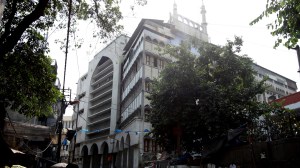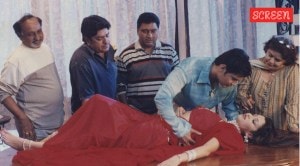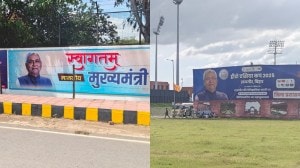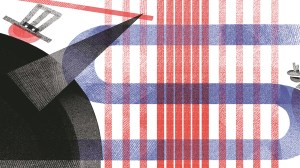CEPT Winter Exhibition: Drawing lessons from the pandemic, students propose ‘inclusive cities’
For the project, students of Urban Design and Faculty of Planning, CEPT University, took the case of street dwellers under flyover in one of Ahmedabad's busiest junctions -- Pakwaan junction -- as a sample.
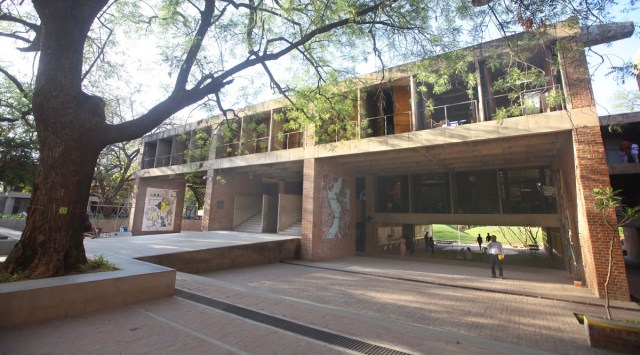 CEPT University campus in Ahmedabad. (Express File Photo)
CEPT University campus in Ahmedabad. (Express File Photo)How do we imagine inclusive public spaces in post-Covid Indian cities? This is one of the questions that 11 undergraduate students of CEPT University tried to address in their project ‘Vulnerability in a Pandemic City’.
The project was among the exhibits at the annual CEPT Winter Exhibition that opened in hybrid mode Monday.
For the project, students of Urban Design and Faculty of Planning, CEPT University, took the case of street dwellers under flyover in one of Ahmedabad’s busiest junctions — Pakwaan junction — as a sample.
Studying over 50 migrant families covering nearly 200 pavement dwellers mostly under the flyover at the Pakwaan junction between August and December 2021, students conducted mapping of the junction-infrastructure development from a timeline starting from 1915, when the first town planning was made, till 2020 and then prepared a detailed map of proposed designs for public space prioritising identified groups as per their needs.
“We studied the different scales of vulnerability they encounter on an everyday basis. On observing the dwellers, it was noted that communities from Rajasthan and other parts of Gujarat migrated there due to precarious circumstances,” shared Anoushka Mukherjee, one of the eleven undergraduate students.
The students mapped their movements and activities across site based on access, infrastructure and livelihoods. The analysis brought out post-pandemic conditions of the dwellers with multiple threats. With the families living in unhygienic conditions, health, security, livelihood, and homes all become a serious threat to the pavement dwellers.
“Quoting the women interviewed, Pooja, a 10-year-old girl who works as a beggar told us about her wish to go to school and learn with her friends living on the pavement. Tejal and Joshna, both 21-year-old mothers, had reproductory health problems but live under ignorance. As we interviewed more people, they started looking forward to discussing their problems with us in hope of getting homes,” added Anoushka.
“Most of the families migrated from small villages of Rajasthan into bamboo craft making who earlier would migrate to other cities like Delhi but after Covid they came to Ahmedabad,” said Naved Ahmed, one of the undergraduate students.
However, due to the pandemic they lost their livelihood. “They left for their villages and returned but they faced issues in returning to their business as they had lost their direct buyers who are now hesitant in rolling down their windows. Many even shifted from bamboo items to selling toys and masks,” he added.
“One pertinent observation was the existing unsanitary practices by the vulnerable throughout the site. The project ‘Leisure and Lavatory’ focusses on understanding the ongoing sanitary practices, on site ground conditions, needs of the pavement dwellers in terms of safety and access, and thereby to design a space that serves the purpose of a cleaner, safer and more accessible toilet and several gathering spaces with provision of education on sanitary practices and disease risks, for them to socialise,” said Aryan Iyer, the teaching assistant for the project.
The studio, a step to understand vulnerability, ended with each of the student coming up with strategies and designing public spaces like training centers, play spaces, vending area to cater to the vulnerable groups and instil a sense of awareness in them.
This design has children’s area, accessible and affordable health care facilities, especially for elderly and disabled, more trees and sittings, green space, a bamboo craft centre, a cycle track and different vending spots in between for different vendors, a learning centre for women and children pavement dwellers.
“‘Public’ should be an inclusive term, disregarding the differences based on caste, religion or income. And yet hostile architecture is a modern urban strategy used to make public spaces inaccessible to huge groups of people such as pavement dwellers… The proposed design creates a space that encourages non-normative engagement using elements like walls and plinths,” Namoshi Basu, one of the eleven undergraduate students writes in her project brief.



